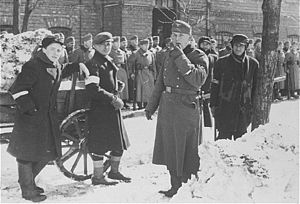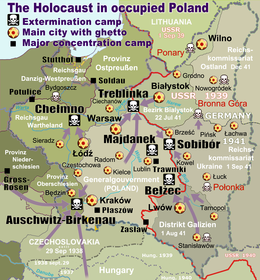Częstochowa Ghetto
| Częstochowa Ghetto | |
|---|---|
 Jewish men clearing snow for German troops, Częstochowa Ghetto, Poland c. 1941–1942 | |
Częstochowa location in the Holocaust in Poland | |
| Location | Częstochowa, German-occupied Poland |
| Incident type | Imprisonment, forced labor, starvation |
| Organizations | Schutzstaffel (SS) |
| Camp | Treblinka extermination camp |
| Victims | 48,000 Polish Jews |
The Częstochowa Ghetto was a
Ghetto history
The official order for the creation of the ghetto in Częstochowa was issued on 9 April 1941 by Stadthauptmann Richard Wendler. In addition to Jews from Częstochowa, more Jews were brought in by rail from nearby towns and villages of the Generalgouvernement part of occupied south-western Second Polish Republic, including from Krzepice, Olsztyn, Mstów, Janów, and Przyrów, on top of expellees from Polish lands annexed into the Reich at the beginning of war, mostly from Płock and Łódź. The ghetto inmates were forced to work as slave labour in the armaments industry, a majority of them in the expanded Polish foundry "Metalurgia" located on Krotka Street (which had been taken over by the German manufacturer HASAG, and renamed Hassag-Eisenhütte AG) as well as in other local factories or workshops.[3]
The Nazis began liquidating the ghetto on 22 September 1942 during
The uprising
Those who survived the main thrust of ghetto liquidation (about 5,000–6,000 slave workers and their families) were put in the so-called Small Ghetto for the Hugo Schneider munitions factory. There, 850 Jews were executed. Soon, a clandestine Jewish Fighting Organisation was formed by Mordechaj Zilberberg, Sumek Abramowicz and Heniek Pesak among others. The organization consisted of 300 members.[3]

When the Germans moved in to liquidate the Small Ghetto on 26 June 1943 the
See also
- Timeline of Treblinka
Notes and references
- ^ Museum of the History of the Polish Jews (in English), as well as "Getta Żydowskie," by Gedeon, (in Polish) and "Ghetto List" by Michael Peters at www.deathcamps.org/occupation/ghettolist.htm (in English). Accessed July 12, 2011.
- ^ a b Shmuel Krakowski (translated from Hebrew by David Fachler) (2010). "Armed Resistance". YIVO Institute for Jewish Research. Retrieved 16 July 2011.
- ^ Museum of the History of Polish Jews. p. 4. Archived from the originalon 20 February 2017. Retrieved 16 July 2011.
- ^ Polscy Sprawiedliwi – Polish Righteous (2015). "The Sitkowski Family". Sprawiedliwy wśród Narodów Świata – tytuł przyznany (Polish Righteous Among the Nations – Titles awarded). Przywracanie Pamięci. Alphabetical listing. Archived from the original on 13 November 2016. Retrieved 23 February 2016.
- ^ Zuzanna Benesz, Polscy Sprawiedliwi (March 2011). "The Koźmiński Family". Sprawiedliwy wśród Narodów Świata – tytuł przyznany. Przywracanie Pamięci. Alphabetical listing. Archived from the original on 13 November 2016. Retrieved 23 February 2016.
- ^ Polscy Sprawiedliwi (2016). "The Klewicki Family". Sprawiedliwy wśród Narodów Świata – tytuł przyznany. Przywracanie Pamięci. Alphabetical listing. Archived from the original on 13 June 2016. Retrieved 23 February 2016.
- ^ Polscy Sprawiedliwi (2016). "The Sikora Family". Sprawiedliwy wśród Narodów Świata – tytuł przyznany. Przywracanie Pamięci. Alphabetical listing. Archived from the original on 13 November 2016. Retrieved 23 February 2016.
- ISBN 978-0313383915.
- ^ "Brust". The Righteous Among the Nations Database. Retrieved 24 May 2020.
50°48′45″N 19°07′38″E / 50.8125°N 19.12730°E

